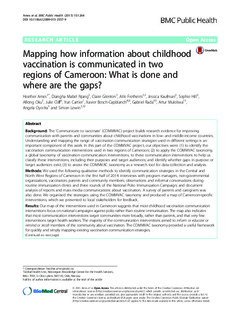| dc.description.abstract | Background: The ‘ Communicate to vaccinate ’ (COMMVAC) project builds research evidence for improving communication with parents and communities about childhood vaccinations in low- and middle-income countries. Understanding and mapping the range of vaccination communication strategies used in different settings is an important component of this work. In this part of the COMMVAC project, our objectives were: (1) to identify the vaccination communication interventions used in two regions of Cameroon; (2) to apply the COMMVAC taxonomy, a global taxonomy of vaccination communication interventions, to these communication interventions to help us classify these interventions, including their purposes and target audiences; and identify whether gaps in purpose or target audiences exist; (3) to assess the COMMVAC taxonomy as a research tool for data collection and analysis. Methods: We used the following qualitative methods to identify communication strategies in the Central and North West Regions of Cameroon in the first half of 2014: interviews with program managers, non-governmental organizations, vaccinators, parents and community members; observations and informal conversations during routine immunization clinics and three rounds of the National Polio Immunization Campaign; and document analysis of reports and mass media communications about vaccination. A survey of parents and caregivers was also done. We organised the strategies using the COMMVAC taxonomy and produced a map of Cameroon-specific interventions, which we presented to local stakeholders for feedback. Results: Our map of the interventions used in Cameroon suggests that most childhood vaccination communication interventions focus on national campaigns against polio rather than routine immunisation. The map also indicates that most communication interventions target communities more broadly, rather than parents, and that very few interventions target health workers. The majority of the communication interventions aimed to inform or educate or remind or recall members of the community about vaccination. The COMMVAC taxonomy provided a useful framework for quickly and simply mapping existing vaccination communication strategies. | |
